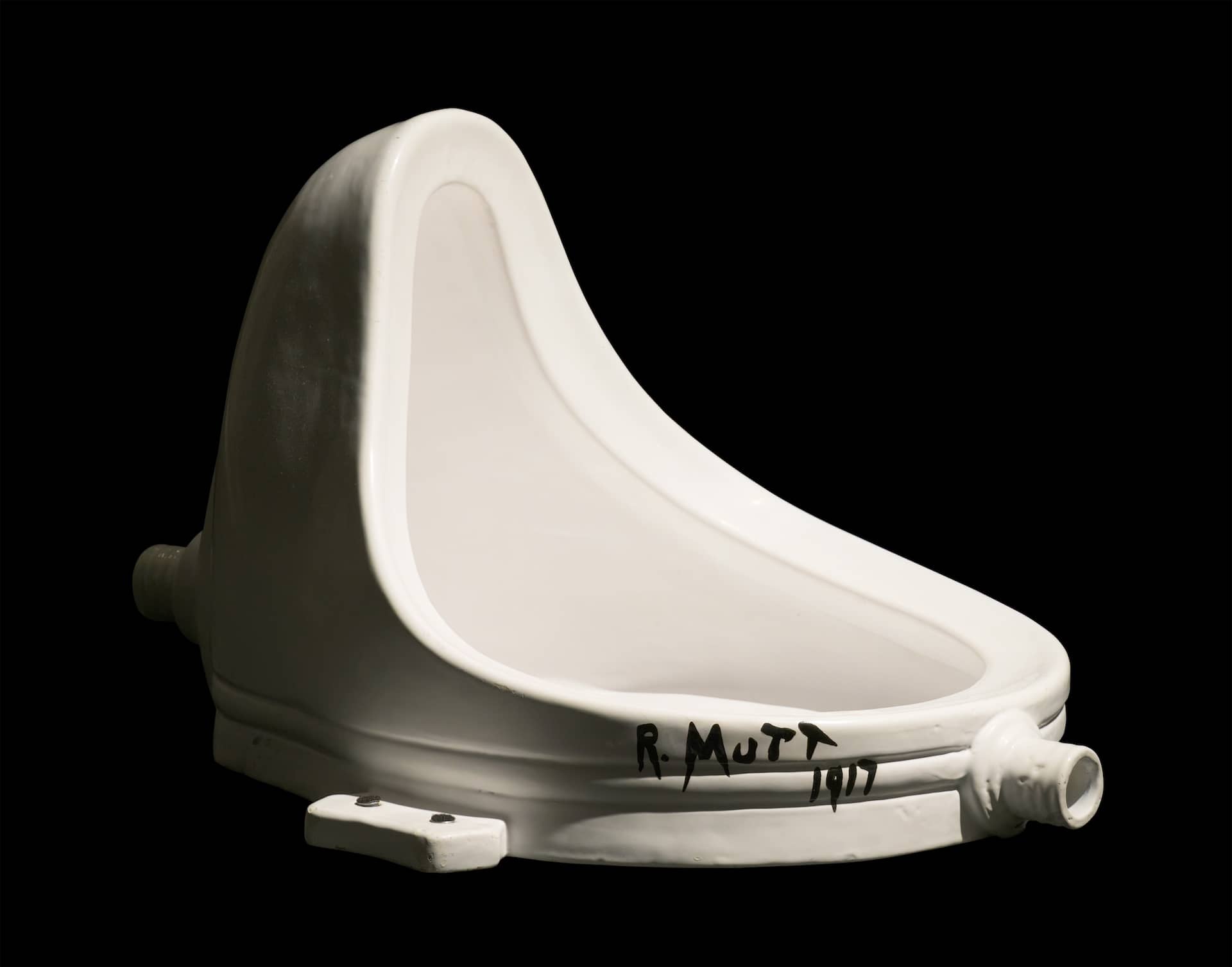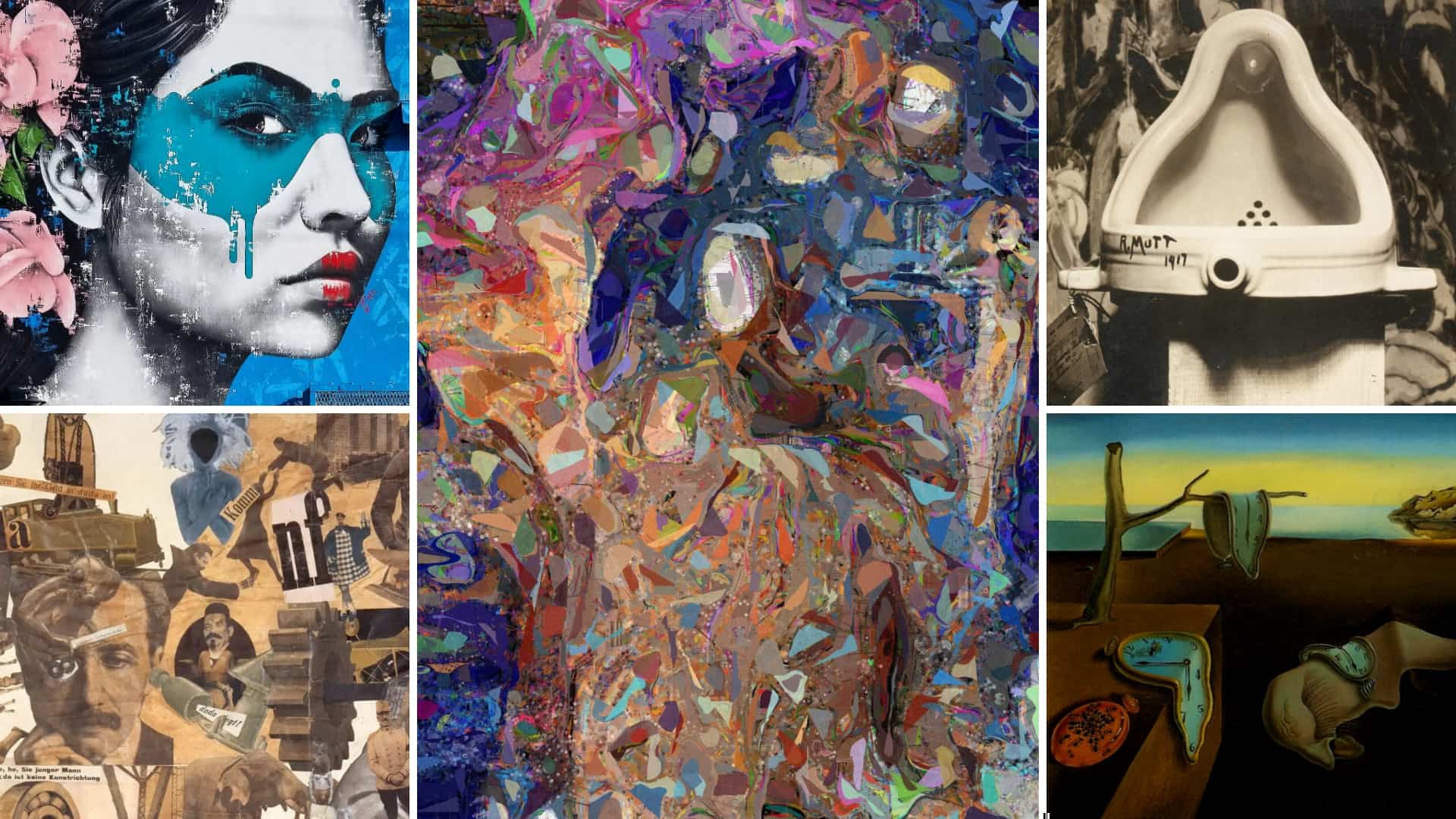Is there power in nonsense? Some might say that nonsense is by definition meaningless. But for Dada artists, nonsense was the ultimate political tool to smash existing power structures and artistic norms. In this article we’ll look at the historical context in which Dadaism artists arose, what Dada looked like, and how it still casts a long shadow over the world today.
What is Dadaism Art Definition
Let's define Dadaism
By its very nature, Dada could take a wide variety of forms. But the art movement had core tenets that each work followed and exemplified. Here’s how you know you’re looking at a piece that has Dadaism characteristics. For more, check out our index of art styles covering more specific and noteworthy movements.
DADAISM DEFINITION
What is Dadaism?
Dadaism is an art movement which arose in 1916 in Zurich, Switzerland, and lasted until the mid 1920s. The movement was firmly planted within the avant-garde, and staunchly rejected any norms of the artistic world at the time. Pure Dada rebuffs reason, logic, and rationality in favor of chance. The movement is explicitly political, representing extreme leftist views, primarily anarchism.
Key Dadaism Artists
- Marcel Duchamp (Painter/sculptor/writer)
- Man Ray (Visual artist)
- Tristan Tzara (Poet)
- Hannah Hoch (Photomontage Artist)
- Hugo Ball (Poet)
- Hans Arp (Sculptor/painter/poet)
In a bubble, it might be hard to understand the appeal of Dadaism characteristics. Why would so many artists turn to Dada — a style which rejects any reason?
What is Dadaism Art Definition?
Where did Dadaism originate?
To understand the Dadaism definition is to understand the effect World War I had on Europe. The unprecedented war ravaged the continent and almost wiped out an entire generation of men.
This in and of itself was devastating, but what was more was that to many, the war was almost entirely pointless and avoidable.
Anyone who has studied just a little about the first World War knows that its beginnings are muddled. Its official inception was with the assassination of Austro-Hungarian Archduke Franz Ferdinand by a Serbian.
But how did this result in a war which involved nearly every major power in Europe? Convoluted alliances, archaic imperial mindsets, and age-old ethnic tensions. Unlike World War II, which was fundamentally a battle to defeat fascism, there was no moral cause to explain why WWI was happening.
The battles wrought by out-of-touch aristocrats and royalty resulted in anger and disillusionment amongst many onlookers. Two of these onlookers were Hugo Ball and Emmy Hemmings, artists who had fled to neutral Switzerland to avoid the war.
The two wanted to create art that reflected the meaninglessness of the mass violence they saw around them. And, thus, they founded Cabaret Voltaire, what would become known as the birthplace of the Dadaism movement.
Dadaist poet Tristan Tzara described Dada’s inception as not coming from art, but from “disgust.”
Dadaism art galore in Cabaret Voltaire • Dadaism meaning
Cabaret Voltaire quickly became popular, attracting Dadaism artists from around the continent like moths to a flame. Its residents didn’t stick to one medium. Sculptures, paintings, poems, music, performance art — all was welcome, as long as it rejected the status quo and embraced nonsense.
The word of the Dadaism movement spread from just the confines of the small cabaret. By 1915, Dadaism was alive and well in New York, and by 1920, it had found a home in Paris. The movement provided the perfect lexicon for leftists who simply couldn’t stomach the imperial bloodshed.
"For [Dadaists], art is not an end in itself, but it is an opportunity for the true perception and criticism of the times we live in."
— Hugo Ball on What is Dadaism?
These artists knew what world leaders would soon learn (though all too late): modernism had reached humanity. In turn, humanity needed to reframe everything it thought it knew. For Dada artists, this was a complete restructuring of the art community. For politicians, this was a rethinking of warfare and, eventually, society.
Dada had a short lifespan, a result of the movement’s very nature. By the mid-1920s, most Dada artists had moved onto new frontiers like Surrealism.
And, because travel was no longer constricted by war, Dadaists spread throughout the world. The movement left a massive impact on the art world, having redefined what art could even be, and remains a testament to the power of political art to this day.
What is Dadaism Art?
Famous Dadaism Art
Some of the most famous and influential artists of the 20th century arose from the Dada movement. Dadaism provided fertile soil for anyone looking to break boundaries and experiment. And, thus, its most well-known works are those which are considered massive steps forward in their respective media.
Karawane, Hugo Ball (1916)
Any clue as to what language Dada’s most famous poem is in? If you answered “no,” you are correct. Hugo Ball’s Dadaist Manifesto is complete gibberish.

What is Dadaism? • Dadaism artworks examples
It was a new kind of poetry, one which simply played with the sound of language. This genre, fittingly, became known as sound poetry.

Hugo Ball performs Karawane at Cabaret Voltaire (1916) • Dadaism artworks examples
The poem, and its performance, is a great testament to the nature of Dadaism. While its politics are very serious, Dada artists often utilized absurdist humor and satire in their works.
Fountain, Marcel Duchamp (1917)
Marcel Duchamp’s Fountain was rejected by the Society of Independent Artists after he submitted it as a sculpture in 1917. The Society claimed that because Fountain was just a urinal that Duchamp had found it did not qualify as art. Duchamp couldn’t have asked for a better response — this was the kind of question Dadaists strove to probe in artistic circles.
Why wasn’t Fountain art? It was sculpted, wasn’t it? It was put on display with artistic purpose, right?

Marcel Duchamp’s Fountain is, well, a urinal • Dadaism examples
With Fountain, Duchamp questioned art’s very nature, while also founding a new style of sculpture which would be called readymade, where artists use existing real-world objects in their installations.
Cut with the Kitchen Knife Dada Through the Last Weimar Beer-Belly Cultural Epoch of Germany, Hannah Höch (1919-1920)
Hannah Höch was one of the few women in the Dada movement, and she was a pioneer in the art of photomontage, in which one cuts up photos and prints and puts them together to create new meaning.

Hoch’s photomontage is a great Dada example • Dadaism painting
Kitchen Knife is one of her most famous examples, seemingly random but loaded with subtext.
Ingres’s Violin, Man Ray (1924)
Man Ray is one of the most famous names to come out of the Dada movement, though arguably his best-known work comes from his involvement afterward in surrealism. Ingres’s Violin provides a look into the shift that was happening in Dada by the mid-1920s.
Man Ray’s iconic take on portrait photography • Dadaism examples
The art here is a bit less random, a bit less avant-garde, but it still incorporates the playfulness and boundary-breaking of Dada. Ingres’s Violin highlights the shift from the Dadaism style to Surrealism, and the influence the former had on the latter.
WHAT IS DADAISM MEANING?
Dada in Film
No artistic medium in the early 20th century was safe from the influence of Dada, and this included the nascent medium of cinema. Dada artists themselves toyed with film. Man Ray’s Le Retour a la Raison is a classic example of Dada on celluloid:
Le Retour a la raison by Man Ray • What does Dadaism mean?
Here among the abstract images we can see Man Ray toying with animation, again a testament to Dada’s experimentation pushing media forward.
Another Dadaist, Hans Richter, created Rhythmus 21:
A Dada example by Hans Richter • What is Dadaism
Rhythmus 21 clearly incorporates other art movements of the time beyond the Dadaism style, like De Stijl, and brings them into the realm of film.
Both Man Ray and Hans Richter transitioned into surrealism after Dadaism, a genre of film which was groundbreaking in its own right. Dada brought to film what it brought to other media with which it was involved: a sense of experimentation and fearlessness which allowed new film techniques to be tested without worrying they would fail.
Dada shifted the Overton window in art — after Dada, what art could be had been drastically expanded and altered. It was a movement that democratized and questioned art, and by doing so, it changed it for the better.
UP NEXT
Explore More Styles and Movements
This was just one of many fascinating segments of art history. There are many eras, styles, artists, and movements to discover. Let's continue our study by choosing the next stop on your way to becoming an art aficionado. Below you can visit our Art Styles Index, our Art History Timeline, or choose an individual movement.
Showcase your vision with elegant shot lists and storyboards.
Create robust and customizable shot lists. Upload images to make storyboards and slideshows.
